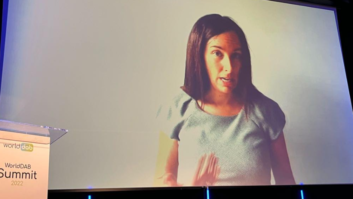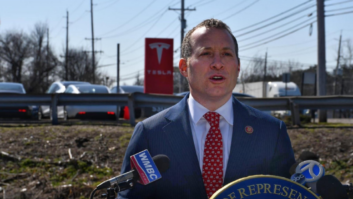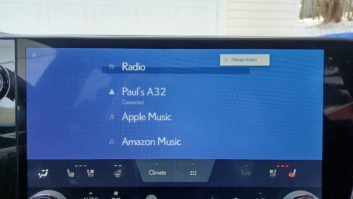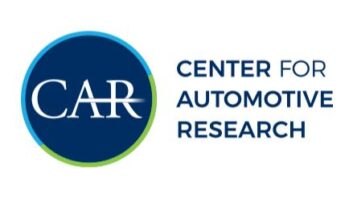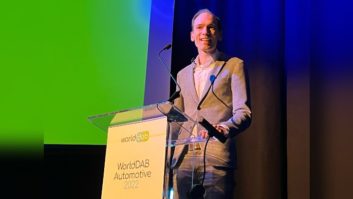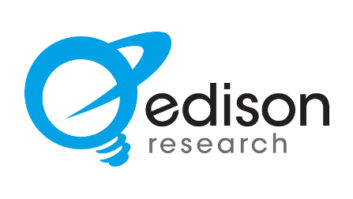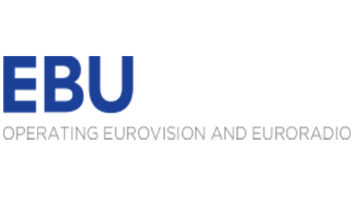
Pure’s Highway 600 DAB car systems features a standalone
control/display unit. Credit: Pure
OTTAWA, Ontario — Boosted by DAB radio promotional campaigns and rollout of DAB networks in their respective countries, the majority of new cars sold in the United Kingdom, Norway, and Switzerland are now equipped with DAB/DAB+ receivers.
“In terms of country level adoption, the U.K. is setting the pace with 82 percent of new cars including DAB as standard — up from 4 percent five years ago,” said Patrick Hannon, president of WorldDAB; the global industry association responsible for defining DAB technical standards and promoting DAB worldwide.
“In Norway, 73 percent of new cars have DAB and in Switzerland the figure is 65 percent of cars with DAB+. “In all territories we are seeing rapid growth.” For the record, the percentage of DAB/DAB+ radios in new cars stands at 24 percent in Italy, 16 percent in the Netherlands, 15 percent in France, 13 percent in Germany, and 5 percent in Denmark — with penetration rates increasing annually. The rate of DAB penetration reflects each country’s level of DAB promotion, DAB coverage, and government/private efforts to offer broadcast content via DAB.
Globally, “Europe is leading the way for DAB in the car and there’s a consensus from governments to make this happen across borders,” said Hannon. “Fifty-six percent of European citizens are now able to receive DAB services and seven countries with national DAB coverage account for 60 percent of new car sales in Europe. France and Belgium have just made further announcements on DAB development, and if you include these, the figure rises to 77 percent.”

Connects2’s SmartDAB FM allows the user to send
DAB audio from their smartphone to an open FM channel
on their analog car radio. Credit: Connects2
DRIVING FACTORS
One reason why in-car DAB is making such progress in Europe is due to automaker support; in response to consumer demand for this technology. Because this demand varies from country to country, the carmakers’ DAB offerings vary in a similar fashion.
For instance, “Ford is offering DAB in all European-delivered vehicles including commercial vehicles,” said Frank Nowack, the executive responsible for Function Owner Multimedia at Ford GmbH. “The offering strategy is market-dependent, so we have some markets like U.K., Norway and Switzerland where DAB is delivered as standard,” Nowack said. “In other markets like Germany, DAB will be offered as an option.”
The same market-by-market approach is being followed by Jaguar Land Rover. “In the U.K. we offer DAB as standard,” said Phil Stuchfield, Jaguar Land Rover’s Broadcast Media Specialist. “In the EU markets, it’s an option for customers. The option take-up is low but growing interest is being seen in a number of key markets; as promotional campaigns push DAB and what it offers.”
So what factors are motivating consumers to want DAB radios in their new cars? Besides widespread DAB coverage throughout much of Europe, drivers are attracted to DAB’s superior performance compared to analog MW(AM) and FM. “DAB guarantees a clear sound quality, CD like, and advanced extra data features like station logos and Electronic Program Guide,” said Nowack. “For technical reasons ‘conventional’ [analog radio] stations can’t deliver these extra services/extra content. Additionally, there are a rising number of radio stations that are broadcasting in DAB only.”
Another factor driving in-car DAB penetration is its high-tech/high-fashion appeal to tech-savvy, digitally connected younger consumers. “In my opinion, it’s choice, ‘something new’ and a look and feel that are better than FM,” said Stuchfield.
A third selling factor for in-car DAB is word-of-mouth advertising by happy in-car DAB users; bolstered by radio’s existing loyalty among European motorists of all ages.
Fundamentally, “drivers really value radio in the car,” said WorldDAB’s Hannon. “Earlier this year the company Radioplayer interviewed 1500 people across the U.K., France, and Germany and found that 82 percent of drivers would not consider buying a car without a radio. Plus 75 percent of all in-car listening is to the radio, even in modern cars.”
That’s the sales case for in-car radio as a whole. When it comes to in-car DAB, “we also know that drivers really like what digital radio offers,” Hannon said. The proof: “Digital Radio UK carried out research last summer and found that 86 percent of people with DAB in the car said that they were very satisfied,” he said.
“Even those currently without DAB are impressed, so much so that 48 percent of those surveyed will ensure the next car they buy has digital radio. This is reflected in the sales growth of DAB. For example, in the U.K. in last 12 months there have been over 2 million cars sold with DAB as standard; compared to 32 million cars on the road in all. During that time listening to DAB in the car has risen from 14.6 percent (of all in-car listening) to 20.4 percent, a rise of 40 percent year-on-year.”

A head-on look at the simple, clear user panel
of the Pure Highway 400. Credit: Pure
CHASING EXISTING CARS
Of course, there are millions of cars currently on the road that came out before in-car DAB was being provided by Europe’s automakers. So when it comes to completing DAB’s reach on Europe’s roadways, “converting existing cars and commercial vehicles to DAB will be the next big challenge,” said Hannon.
Taking up the existing car/truck DAB challenge are receiver makers such as Connects2 and Pure. Connects2’s broad DAB product line includes: SmartDAB AUX/SmartDAB RF — DAB fed from the user’s smartphone into a car receiver’s aux input; SmartDAB FM/SmartDAB RF — broadcast from a smartphone to the car’s FM tuner; SmartDAB BT — sent from a smartphone via Bluetooth to the car’s Bluetooth-equipped receiver; AutoDAB SWC — installed in the car behind the dash, this DAB receiver is controlled by the car’s existing radio; AutoDAB RF/FM — same as the AutoDAB SWC but controlled by a small remote with information being displayed on the car radio’s display; AutoDAB GO — same as the AutoDAB RF/FM but with its own color display and Bluetooth for telephone.
“The majority of new cars already come as DAB standard or available as an upgrade option,” said Graham Johnson, Connects2 business development manager. “Our products are designed where this is not an option so you can continue to use your existing car radio and upgrade to DAB radio.”

Units like the Pure Highway 400 can also accept audio
from smartphones via a Bluetooth link. Credit: Pure
Although Pure has traditionally focused on set-top and portable DAB receivers, the existing car market has long been in the company’s sights. “As the pioneers of digital radio and the first company to fully embrace the technology in 1999, we feel we had a sense of duty to the industry to continue innovating in this area,” explained Jasper Wybrants, Pure’s head of automotive.
“In 2007, we launched the world’s first in-car digital radio adapter, the original Highway. This year we have rolled all our experience into exciting new adapters — the Highway 400 and Highway 600 — that we know will be a real game changer.”
Pure’s Highway 400 and Highway 600 are both designed to connect to a car’s existing sound system, with both units providing standalone displays and tuning controls. The difference between the two is that the Highway 600 supports hands-free telephone calling using its noise-cancelling microphone. “Both head units are wireless, so you can put them wherever you want on your dashboard,” said Wybrants.
Using either model, users can tune into DAB/DAB+ broadcasts, and stream audio via Bluetooth from their smartphones to their Highway unit. Meanwhile, the available Android/Apple Pure Go app allows Highway 400/600 users to press the “Highway Tagging’ button on their Highway unit; “identifying and automatically storing your favorite tunes heard on the radio onto your Pure Go Spotify playlist to enjoy later,” Wybrants said.
“With over 82 percent of new (U.K.) cars now with DAB digital radio as standard, car manufacturer obviously believe there is a demand, as do we,” added Wybrants. “Even with this figure there are around 2 million cars on the road that need an aftermarket solution, which is where our Highway products bridge the gap.”

Connects2’s SmartDAB AUX transmits DAB from the user’s
smartphone into their car radio’s aux input and the user
interface is your phone. Credit: Connects2
A COMPETITOR TO FM?
Given all the progress that in-car DAB is making in Europe, one has to wonder: Is this digital medium on its way to equaling — or even eclipsing — FM radio in the car?
On this point, opinions are mixed. “In Europe, DAB has a strong chance of being as popular or more popular as FM,” said Stuchfield. “But there is still a coverage advantage for FM, so until this is addressed for most users, there will be some reluctance to jump.”
“This will be very different depending on which countries in Europe you are talking about,” said Nowack. “In the U.K., Norway and Switzerland I would say yes. In other markets I don’t know. I’m pretty sure that the market penetration of DAB will not be high enough in markets where the customers/listeners don’t get a clear statement of support from the broadcasters and the government.”
Whatever happens, in-car DAB radio has become a force to be reckoned with in Europe. The success of this technology and this medium indicates that the much-talked-about analog-to-digital transition is finally underway.
James Careless reports on the industry for Radio World from Ottawa, Ontario.





